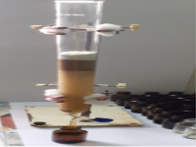Abstract
Natural compounds that occur either in pure form or as extract after standardization from medicinal plants, provide a limitless chance for new discovery leads because of consummate chemical diversity. The rising demand for compounds that occur naturally during screening studies, that has therapeutic action predominantly on the vegetative part of the plant has grown across the world. In this study, Papaverine compound was isolated from aqueous Ethanolic extract (80%) from vegetative (leaf) part of herbal plant Erythrina subumbrans (Hassk.) Merr. Isolated compound was subjected for characterization studies like Thin layer chromatography (TLC), Mass spectrophotometry (MS), Fourier Transform Infra-Red (FTIR), 1H and 13C Nuclear magnetic resonance spectroscopy. Confirmatory study using the aqueous ethanolic crude extract by MS technique and mass library match confirms the presence of Papaverine compound. Further, in-vitro cytotoxic activity using Human Melanoma cell line (A375) was carried out using the isolated compound (papaverine), Aqueous ethanolic extract and standard Cisplatin. Six different Concentration ranging from 3.125 to 100 µg/ml were prepared. Control samples were prepared without standard and samples solution. Absorbance measured at 570 nm in UV-Vis spectrophotometer using a microplate reader and the % of viability was calculated. IC50 value of Aqueous ethanolic extract of Erythrina subumbrans, isolated compound-Papaverine and standard Cisplatin exhibits value of 82.14µg, 23.43 µg & 4.02 µg respectively.
Full text article
References
Cos, P., Vlietinck, A. J., Vanden Berghe, D., Maes, L. 2006. Anti-infective potential of natural products: How to develop a stronger in vitro ‘proof-of-concept’. Journal of Ethnopharmacology, 106(3):290–302.
Crouch, S. P. M., Kozlowski, R., Slater, K. J., Fletcher, J. 1993. The use of ATP bioluminescence as a measure of cell proliferation and cytotoxicity. Journal of Immunological Methods, 160(1):81–88.
Dantu, A. S., Shankarguru, P., Ramya, D. D., Vedha, H. B. 2012. Evaluation of in vitro anticancer activity of hydroalcoholic extract of Tabernaemontana divaricata. Asian J Pharm Clin Res, 5(3):59–61.
Duraipandiyan, V., Ayyanar, M., Ignacimuthu, S. 2006. Antimicrobial activity of some ethnomedicinal plants used by Paliyar tribe from Tamil Nadu, India. BMC Complementary and Alternative Medicine, 6(1):35–41.
Ferlay, J., Shin, H.-R., Bray, F., Forman, D., Mathers, C., Parkin, D. M. 2010. Estimates of worldwide burden of cancer in 2008: GLOBOCAN 2008. International Journal of Cancer, 127(12):2893–2917.
Gonzalez, R. J., Tarloff, J. B. 2001. Evaluation of hepatic subcellular fractions for Alamar blue and MTT reductase activity. Toxicology in Vitro, 15(3):257– 259.
Gullett, N. P., Amin, A. R. M. R., Bayraktar, S., Pezzuto, J. M., Shin, D. M., Khuri, F. R., Aggarwal, B. B., Surh, Y.-J., Kucuk, O. 2010. Cancer Prevention with Natural Compounds. Seminars in Oncology, 37(3):258– 281.
Hattori, N., Sakakibara, T., Kajiyama, N., Igarashi, T., Maeda, M., Murakami, S. 2003. Enhanced microbial biomass assay using mutant luciferase resistant to benzalkonium chloride. Analytical Biochemistry, 319(2):287–295.
Jemal, A., Siegel, R., Ward, E., Murray, T., Xu, J., Thun, M. J. 2007. Cancer Statistics, 2007. CA: A Cancer Journal for Clinicians, 57(1):43–66.
María, R., Shirley, M., Xavier, C., Jaime, S., David, V., Rosa, S., Jodie, D. 2018. Preliminary phytochemical screening, total phenolic content and antibacterial activity of thirteen native species from Guayas province Ecuador. Journal of King Saud University Science, 30(4):500–505.
Popoca, J., Aguilar, A., Alonso, D., Villarreal, M. L. 1998. Cytotoxic activity of selected plants used as antitumorals in Mexican traditional medicine. Journal of Ethnopharmacology, 59(3):173–177.
Shah, U., Shah, R., Acharya, S., Acharya, N. 2013. Novel anticancer agents from plant sources. Chinese Journal of Natural Medicines, 11(1):60002– 60005.
Sudhakar, K., Sangeetha, M., Sathish, S., Gayathri, P., Chamundeeswari, D. 2019. Invitro Cytotoxic Activity of Ethanolic Extract of Reissantia indica on the Human Colon Cancer Cell Line (HT-29). International Journal Of Pharmacognosy And Phytochemical Research, 11(1):1–4.
Authors

This work is licensed under a Creative Commons Attribution-NonCommercial-NoDerivatives 4.0 International License.

